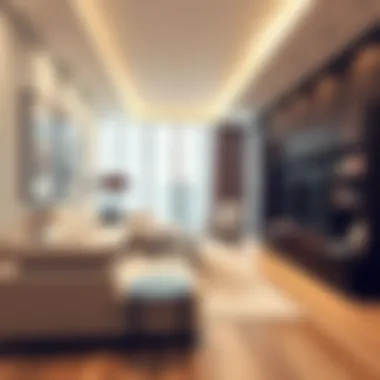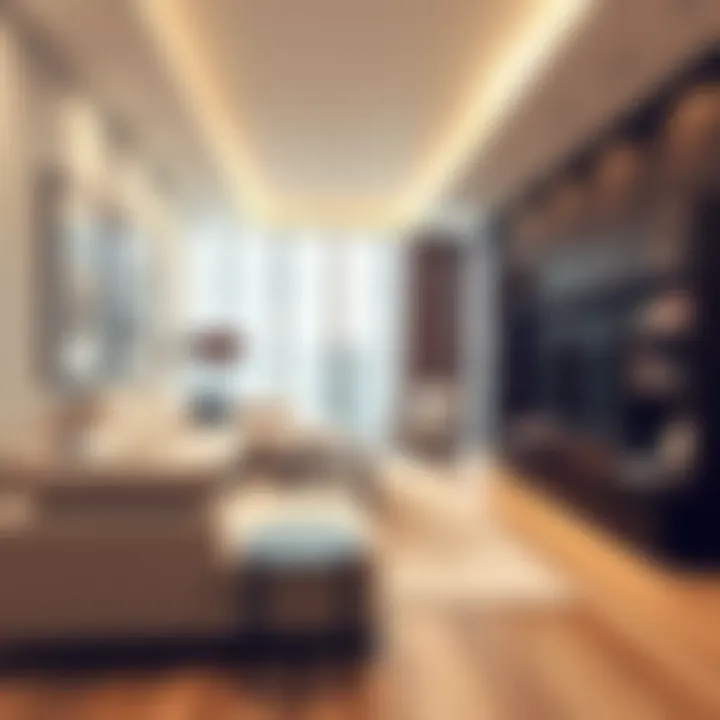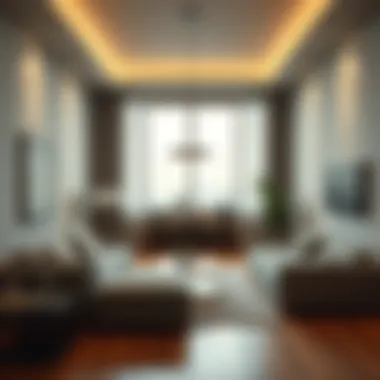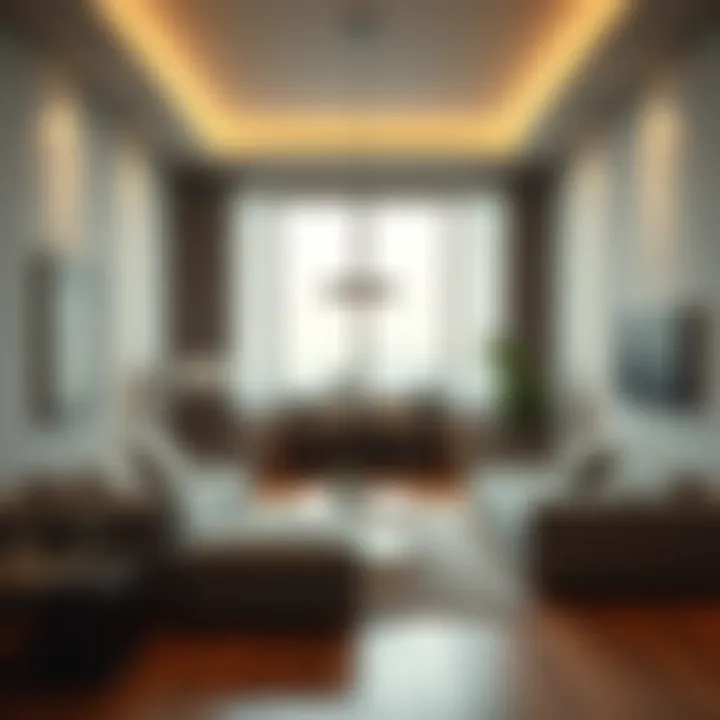The Evolution of Room Blueprint Makers in Design


Intro
The art of creating room blueprints has grown tremendously over the years, shifting the dynamics of how we visualize living spaces. In the bustling sectors of furniture and interior design, room blueprint makers serve as the backbone for effectively translating ideas into tangible designs. For designers, homeowners, and even retailers, the act of constructing a room layout can feel akin to assembling a complex puzzle. Every piece—from furniture placement to the colors on the walls—plays a vital role in the bigger picture of an inviting home.
Throughout history, the methodologies behind designing spaces have evolved, mirroring shifts in societal norms, technological advancements, and our understanding of space utilization. As we journey through the tale of room blueprint makers, we’ll uncover the significance of their craft, the evolution of tools employed, and how modern digital platforms reshape the design landscape. This exploration isn't just about drawing lines on paper or clicking points on screens; it’s about shaping environments that enhance the human experience.
In this article, we will look into various aspects, such as furniture trends, the modern aesthetics involved in these designs, innovative materials and technologies, and the skills required to master the art. Additionally, we’ll touch on the future of this field, emphasizing flexibility and the role of digitalization in crafting blueprints. With the rapid changes in design approaches, what has remained constant is the enduring relevance of effective blueprint-making in creating spaces where life unfolds.
In short, this comprehensive overview serves not just as a guide, but as an invitation to deepen your understanding of how room blueprint makers impact the ever-evolving world of interior design.
Prolusion to Room Blueprint Makers
In a world that often seems to be increasingly fast-paced and digital, the notion of room blueprint makers resonates profoundly with those who desire a tangible sense of space and design. These figures, whether they are individuals or software, encapsulate a spectrum of ideas—from artistic expression to pragmatic functionality. They lay the groundwork for any design project, ensuring that every square inch of a room serves not just a purpose but also a narrative.
Blueprint makers are particularly significant because they bridge the often-unbridgeable gap between vision and reality. Architects and designers rely on them to vividly visualize the intended outcome of a space, allowing all stakeholders—from homeowners to contractors—to share a common understanding. Without a solid blueprint, concepts can become lost in translation, leading to lackluster results or, worse yet, costly errors.
Defining Room Blueprint Makers
Room blueprint makers comprise a diverse group ranging from traditional draftsmen wielding pencils and T-squares to advanced digital software that creates intricate designs with just a click. At their core, these tools and individuals help to create a representation of space that embodies both aesthetics and functionality!
They can be categorized into a few main types:
- Manual Blueprint Makers: Traditionally associated with drafting tables, these makers rely on simple tools like compasses, straightedges, and graph paper. The precision needed for manual designs is no walk in the park but can bring a certain charm that modern methods sometimes lack.
- Digital Software Solutions: Programs like AutoCAD and SketchUp have revolutionized room design. They offer a myriad of features, including 3D modeling and simulation capabilities, allowing designs to be tested and tweaked before any actual work begins.
- Mobile Applications: Applications such as MagicPlan and RoomScan make it easier for homeowners and interior designers alike to create blueprints on the fly. With features like camera integration and simple drag-and-drop capabilities, these tools cater to a more casual user who wishes to engage more deeply in the design process.
Historical Context of Room Design
Understanding the history of room design underscores the significant evolution room blueprint makers have undergone. Thousands of years ago, designing spaces was often an organic process. Early humans utilized natural formations and simple concepts to create dwellings with little regard for structural integrity or aesthetics.
As societies developed, so did the methods of designing and constructing spaces. The ancient Egyptians laid out their architectural designs on papyrus, while the Greeks and Romans began using more structured approaches, integrating mathematics for precise measurements.
During the Renaissance period, the importance of blueprints became clearer than ever as the architectural landscape evolved. Innovators like Leonardo da Vinci blended art with engineering, paving the way for the more detailed and complex designs that we see in modern architecture. This era cemented the idea that thoughtful design can enhance both functionality and beauty in any space.
Today, with the impact of technology, the scope of room blueprint makers has broadened dramatically. From real-time modifications in digital software to collaborative platforms that allow multiple users to edit and visualize spaces simultaneously, the evolution looks promising as tools become more accessible than ever. This change highlights how, as our needs and technologies evolve, so must our approach to room design and planning.
Importance in Interior Design
Designing a space goes far beyond mere decoration; it's about crafting an environment that resonates with its users on a deeper level. The role of room blueprint makers becomes central in achieving this goal. By providing a visual representation of a space, these tools not only aid in conceptualization but also serve as the backbone of effective interior design practices. This section explores how these blueprints facilitate thoughtful design decisions and promote collaboration among various stakeholders, thereby enhancing overall project outcomes.
Visualizing Space Layouts
Imagine stepping into a room where every corner feels intentional. This sense of flow and ease doesn’t happen by accident. Room blueprint makers are vital in visualizing space layouts. They help individuals, be it homeowners or designers, to see the potential of a room before a single piece of furniture is moved in. The importance of such visualization can’t be overstated. It allows for experimentation with different configurations.
A few key benefits of visualizing space layouts include:
- Clarity in Planning: Clear layouts help prevent costly mistakes by showcasing how various elements will interact within a space.
- Informed Decision-Making: Visuals contribute to making more educated choices regarding furniture sizes and styles, ensuring that each piece fits well within the overall aesthetic.
- Enhancing Usability: By critically analyzing spatial relationships, designers can optimize traffic flow and functionality, making spaces more efficient for their intended use.
For instance, utilizing digital software like SketchUp or AutoCAD allows users to manipulate layouts in real-time, providing an immersive experience that static drawings cannot match. This flexibility unleashes creativity, enabling a design that is not only beautiful but practical.
Facilitating Communication Among Stakeholders
A successful design project hinges on effective communication among various parties involved. Room blueprints serve as a universal language that bridges the gap between architects, designers, contractors, and clients. The clarity these blueprints offer helps in aligning everyone's vision and expectations from the very beginning.
The ways in which blueprints facilitate communication include:
- A Shared Reference Point: Blueprints provide a clear visual reference that everyone can discuss and modify. This ensures that there is no room for misinterpretation regarding design elements.
- Streamlining Decision Processes: When all stakeholders are aligned, decision-making becomes swifter, reducing delays that often plague design projects.
- Documentation for Future Reference: Well-documented blueprints can serve as a valuable resource for future renovations, ensuring collective memories of design decisions are preserved.
Ultimately, when everyone speaks the same architectural language, the results can be both innovative and cohesive. In effect, blueprints don’t just lay the foundation for one project, but they can influence a series of successful transformations down the line.
"A picture is worth a thousand words," they say, and in the world of room design, a well-crafted blueprint can indeed prevent thousands of mistakes.
The importance of room blueprint makers within the realm of interior design cannot be overstated. They streamline the design process, enhance communication, and offer an exquisite blend of art and function. Each room tells a story, and the blueprint is its first draft.
Types of Room Blueprint Makers
The role of room blueprint makers is pivotal to the design and functionality of living spaces. They act as a bridge between vision and reality, translating ideas into tangible blueprints that guide both construction and decoration. This section will uncover the various categories of tools and resources that aid designers, architects, and homeowners in creating effective and visually appealing blueprints. Each type of room blueprint maker comes with its own set of benefits and considerations, shaping how spaces are planned and utilized.


Traditional Drafting Tools
Many may hark back to the days when drafting was solely reliant on manual methods. Traditional drafting tools remain relevant even in the age of technology. These tools—like T-squares, protractors, and compasses—provide a tactile experience that some designers truly cherish.
Designers often consider the following elements while employing traditional drafting:
- Precision: With manual tools, one can often get a feel for dimensions and ratios that digital tools sometimes obscure.
- Customization: Designers can easily adjust plans based on immediate feedback, sketching amendments directly onto the paper.
- Accessibility: Not everyone has access to high-end tech; sometimes, all you need is a pencil and a good ruler to get started.
Of course, traditional methods have their challenges. They can be time-consuming, and it is easy to make mistakes that can lead to inefficiencies. Nonetheless, many professionals still use these methods to supplement digital solutions, appreciating the artistic aspect of designing spaces.
Digital Software Solutions
Shifting gears into the digital realm, design software has revolutionized the way blueprints are conceived and executed. These solutions offer a virtual playground where designers can truly experiment with space without the risk of waste. Software like AutoCAD, SketchUp, and Revit are just some examples that help streamline the entire design process.
Benefits of using digital software include:
- Speed: Time-consuming tasks like measurements and rendering can be completed in a fraction of the time.
- Visualization: Software often provides rendering capabilities, allowing designers to visualize how a space will appear before it is built.
- Collaboration: Multiple stakeholders can view and edit designs in real-time, facilitating better communication and understanding of the project.
However, with great power comes responsibility. Understanding these programs requires a learning curve, and for some, this can pose a barrier to entry. Designers must keep up with constant updates and features that can sometimes complicate workflows instead of simplifying them.
Mobile Applications for On-the-Go Planning
In an era where smartphones dominate, mobile applications have emerged as a popular tool for quick and efficient room planning. Apps such as RoomScan Pro, MagicPlan, and Home Design 3D allow users to create blueprints straight from their devices. They bring a new level of accessibility that traditional and even digital solutions may lack.
Key features of mobile applications include:
- Convenience: Users can sketch and modify designs anywhere, making it ideal for impromptu consultations or changes on site.
- User-friendly interfaces: Many apps offer intuitive layouts designed for people with little to no experience in design.
- Cost-effective: Many applications are available for free or at a low cost, providing an economical option for homeowners.
On the flip side, the apps may not always provide the depth or detail that professional designers prefer. While they’re great for rough drafts or preliminary ideas, reliance on them without a solid comprehension of design principles can lead to subpar outcomes.
"Tools evolve, but the essence of effective design remains the same: understanding the needs of the space and its users."
In summary, understanding the different types of room blueprint makers is essential for anyone engaged in space design. Whether one opts for the familiarity of traditional tools, the speed of digital software, or the mobile convenience of apps, each type offers unique advantages and challenges. The choice largely hinges on an individual’s needs and circumstances, reflecting the diverse landscape of room design.
Key Principles of Effective Room Design
Effective room design isn’t just about placing furniture in a pleasing way. It’s more like weaving a tapestry where every thread counts. The principles of effective room design are crucial, as they entwine functionality, aesthetics, and environmental considerations into a cohesive strategy. Understanding these principles can transform an average space into a sanctuary that enhances both comfort and usability. This section will delve deep into the core tenets of effective room design by examining functionality in space utilization, aesthetics and cohesion, as well as the role of natural light.
Functionality in Space Utilization
The heart of any well-designed room is functionality. Aesthetics don’t mean much if a space can’t be used effectively. Think about it: can you maneuver around the room without bumping into something? Is there enough space to breathe, let alone appreciate the decor?
When planning a room, one should consider the daily activities that will transpire within those walls. Here are some key considerations:
- Traffic Flow: Paths should be clear. Imagine a dance floor where everyone steps on each other's toes; that’s akin to a poorly designed room layout.
- Zones: Create purpose-driven areas. A living room should offer a cozy seating space, but also have an area for movement. This can be as simple as positioning a coffee table a few feet away from the sofa so guests can settle comfortably.
- Adaptability: Trends change, and so do family needs. Rooms should be designed to allow for easy rearrangement. This flexibility is particularly vital for multipurpose spaces, commonly seen in homes with limited square footage.
Designers must recognize that the success of spatial utilization greatly impacts how inhabitants perceive comfort and functionality in their everyday lives.
Aesthetics and Cohesion
Beyond functionality lies aesthetics, which connects the visual dots of a room. Cohesion, that delightful harmony between colors, textures, and forms can make or break a space.
When approaching aesthetics, consider the following:
- Color Palette: Choose a color scheme intentionally. This doesn’t mean every wall must be painted the same shade, but rather that complementary colors can create balance. For instance, pairing earthy tones with crisp whites exudes a calming feel, while bold contrasts may spark vibrancy and energy.
- Textures and Patterns: An interplay of textures such as smooth leather, soft wool, and rustic wood can invite touch and evoke emotion. Patterns can enhance visual interest, but moderation is key—too many can clash like a group of off-key singers.
- Personal Touches: Craftsman-style furniture may fit perfectly in a traditional home, but introducing modern art pieces can add a fascinating twist. Striking a balance between personal style and cohesive design ensures that the room doesn’t feel like a mismatched ensemble.
When the elements coalesce to tell a singular story, a room becomes a space that resonates well with its inhabitants.
Incorporating Natural Light
Natural light serves as the unsung hero of effective room design. The way light dances across surfaces and fills spaces can dramatically affect mood and perception. A well-lit room feels larger, more inviting, and more alive.
To harness this power, consider the following:
- Window Placement: Room design should take advantage of natural light sources. Arrange spaces to face larger windows or skylights, maximizing sunlight influx, lest the room feel like a dark cave.
- Reflective Surfaces: Mirrors aren’t just for last-minute checks before leaving home. Strategically positioning mirrors can amplify light and create illusions of spaciousness. Think of them as your secret weapon in small areas.
- Organic Materials: Wood, stone, and glass not only attract light but reflect warmth as well. Incorporating these materials can enhance a room’s overall feel and allow for a deeper connection with the outdoors.
Skills Required for Blueprint Creation


Creating blueprints is not just about drafting lines and shapes on paper or screen; it's a nuanced process that requires a blend of artistic vision and technical finesse. Designers, retailers, homeowners, decorators, and architects all benefit tremendously from understanding the key skills needed in this domain.
Understanding Spatial Relationships
For starters, a solid understanding of spatial relationships is paramount. This skill allows designers to visualize how objects will interact within a given space. It’s more than just knowing how to fit a sofa between two walls; it’s about grasping how movement flows within that space.
Think about it: you wouldn't place a coffee table smack in the center of a high-traffic area. Understanding spatial relationships helps avoid these rookie mistakes that can make a room feel cramped or chaotic. When designers use this skill effectively, they can create layouts that maximize utility while maintaining aesthetic appeal.
"Good design is all about the balance between beauty and function."
Technical Proficiency with Design Software
In today's digital world, being technically proficient with design software is no longer optional; it's a requirement. This skill entails familiarity with various programs such as AutoCAD, SketchUp, and Revit. Each software offers unique tools that can enhance blueprint creation.
For instance, AutoCAD facilitates precision drafting, while SketchUp provides a three-dimensional perspective, allowing designers to manipulate elements and better visualize outcomes. Being comfortable with these resources enables designers to bring their ideas to life, ensuring that all measurements align and that the overall flow of the space is coherent.
Moreover, as technology continues to evolve, staying updated with the latest software trends is essential for maintaining a competitive edge in the field.
Attention to Detail
Lastly, we cannot underestimate the importance of attention to detail. Every line, curve, and measurement must be precise. A minor miscalculation could lead to significant issues, especially when it comes to installation and construction. Failing to account for things like doors swinging open or light fixtures hanging low can create unexpected headaches during the build phase.
Incorporating small details, such as highlighting built-in cabinetry or the alignment of furniture pieces with architectural features, adds richness and clarity to blueprints. It’s these details that often make the difference between a good blueprint and a great one, allowing for seamless execution of the design intent.
Incorporating Sustainability in Room Design
Sustainability has become a crucial consideration in interior design. As awareness about climate change and resource depletion grows, the design industry is increasingly leaning towards eco-friendly practices. Incorporating sustainability in room design not only benefits the environment but also enhances the well-being of occupants. The principles of sustainable design prioritize efficiency and reduced ecological impacts, urging designers to think beyond traditional practices.
By adopting sustainable strategies, interior spaces can be optimized for energy usage, which is a win-win situation. Among the core elements are the materials used and how space is utilized. This leads us to explore the significant aspects of using eco-friendly materials and sustainable space solutions.
Using Eco-friendly Materials
When it comes to creating sustainable interiors, the choice of materials plays a pivotal role. Eco-friendly materials include anything from responsibly sourced wood to recycled metals and non-toxic paints. Not only do these materials minimize ecological damage, but they often provide better indoor air quality compared to conventional counterparts.
Using sustainable materials has its perks:
- Reduction of Carbon Footprint: By opting for materials that are locally sourced or have minimal processing, designers can significantly lower emissions associated with transportation and production.
- Durability: Many eco-friendly materials offer superior durability, meaning they last longer and reduce the need for frequent replacements. A classic example is bamboo, which grows rapidly and replaces itself naturally, making it an excellent choice for flooring.
- Healthier Living Environments: Non-toxic paints and finishes contribute to better indoor air quality, making spaces healthier for occupants.
Additionally, embracing eco-friendly materials can increase the desirability of properties. Today, homeowners are more inclined towards sustainability, allowing designers who incorporate such items to cater to a broader market.
Sustainable Space Solutions
Another crucial factor in sustainable interior design is the way space is managed. Sustainable space solutions emphasize maximizing the utility of a given area while minimizing resource consumption. Here are some considerations:
- Flexible Spaces: Designing multi-functional areas can reduce the overall need for expansion, promoting versatility without excessive resource use. A great example would be a living room that doubles as a workspace, eliminating the need for a separate office.
- Natural Ventilation: This strategy encourages the flow of fresh air without relying heavily on mechanical systems. By positioning windows strategically or selecting ventilation features, spaces can breathe better and reduce energy reliance.
- Smart Technology: The use of smart home technology supports sustainability. Automated systems can optimize energy use based on occupancy, adjusting heating and cooling as needed, leading to significant reductions in energy use.
Utilizing these sustainable space solutions not only minimizes the ecological impact but also creates harmonious living conditions. With a little creativity, any space can transform into an eco-friendly oasis.
"The integration of sustainable practices is no longer optional; it’s a necessity for designers wanting to create spaces that respect both people and the planet."
Emerging Trends in Room Blueprint Making
Emerging trends in room blueprint making signify a paradigm shift in how designers and architects create spaces. The industry is constantly evolving, and these trends not only enhance creativity but also improve efficiency and sustainability in design. As technology continues to advance, the integration of innovative tools and methods becomes paramount. This section dives into the prominent trends reshaping room blueprint creation, underscoring their importance in the contemporary design landscape.
Virtual Reality Applications
Virtual reality (VR) has started to revolutionize the way designers approach room blueprint making. With immersive technology, designers can showcase their visions in a three-dimensional space, giving clients an interactive experience that paper sketches simply can’t match. With VR applications, a client can step into a digital replica of their future room, walking around, analyzing space, and even visualizing different layouts and color schemes.
The benefits of using VR in blueprint creation are manifold:
- Enhanced Visualization: Clients don’t need to rely on abstract concepts; they see their envisioned space in real time.
- Reduced Errors: By engaging with the design early on, clients can spot issues or changes they want before any physical work begins, which can save both time and resources.
- Increased Collaboration: When various stakeholders, such as architects, designers, and homeowners, immerse themselves in the same virtual environment, communication improves drastically.
For instance, a firm could present multiple iterations of a room design using VR headsets. This immersive experience engages clients significantly, enabling them to make informed decisions and reducing potential disagreements later in the project. As this technology continues to develop, it becomes increasingly vital for designers to incorporate virtual reality into their workflow.
3D Printing in Furniture Design


On the other hand, 3D printing is another groundbreaking trend impacting room blueprint making. This innovative technology allows for the creation of custom furniture and décor that perfectly fits a specified design. Imagine a room blueprint where every piece of furniture—be it a unique table or an intricate lamp—reflects the client's taste and the designer's vision.
Some of the advantages of integrating 3D printing into room design include:
- Customization: Individualized pieces can be produced without the long lead times associated with traditional manufacturing.
- Cost-Effectiveness: While initial setup can be pricey, the ability to create products on-demand can lead to savings, particularly for small firms.
- Sustainability: Many 3D printers today utilize biodegradable materials, aligning with the growing demand for eco-friendly design.
From creating quirky furniture shapes to tailored lighting solutions, designers can bring their blueprints to life in ways that were previously inconceivable. This trend not only fosters creativity in the design process but also caters to the modern consumer's desire for personalization and sustainability.
"The integration of virtual reality and 3D printing into the blueprint-making process is not just about changing tools; it’s about redefining the essence of design itself."
With these emerging trends, the landscape of room blueprint making continues to flourish, and those in the furniture and interior design industry must adapt to these innovations to remain competitive.
For further reading on the impact of technology in design, consider resources from Encyclopedia Britannica, Reddit, and Wikipedia.
Case Studies on Successful Room Designs
Exploring real-world examples of room designs that have excelled offers invaluable insight into the practical application of concepts and tools we've discussed in this article. Case studies allow designers, homeowners, and industry professionals to analyze successful strategies and reconsider their own methods. They illuminate how effective blueprints translate into functional and aesthetically pleasing spaces. From urban apartments to cozy homes, each case provides a glimpse into the creativity and strategic thinking that underpins effective room design.
Innovative Uses of Space in Urban Settings
Urban living often comes with its unique set of challenges, particularly when it comes to space. Cities are notorious for their compact living arrangements, where every square inch counts. This leads to innovative uses of space that reflect both necessity and ingenuity. One notable case is the transformation of an outdated warehouse in New York City into modern loft apartments.
Through careful blueprinting, designers utilized open-plan layouts, effectively maximizing natural light and creating multifunctional areas. Kitchen islands doubled as dining spaces, while bright wall colors enhanced the feeling of openness. This case exemplifies how thoughtful planning and creative spatial arrangements can turn potential limitations into engaging, functional homes.
- Key Benefits:
- Maximizes space efficiency
- Enhances natural light
- Encourages multifunctionality
A similar approach emerges in tiny homes, which have skyrocketed in popularity. Designers focus on maximizing vertical space—think of lofted beds and built-in storage—transforming small areas into remarkably spacious living environments. Each decision in these designs pivots on effective blueprints, emphasizing how planning can yield significant spatial benefits even in restricted contexts.
Remodeling Challenges Overcome by Effective Blueprints
Remodeling presents challenges that can test any designer’s mettle. Effective blueprints serve as a navigational tool through these potential pitfalls, guiding professionals to avoid common mistakes. A case that illustrates the power of strategic blueprints is the renovation of a mid-century home in California.
The homeowners faced an outdated layout that did not flow well for their modern lifestyle. Through detailed planning, designers not only updated the aesthetics but also ensured functional enhancements to circulation patterns. Aligning the kitchen with the dining room allowed for smoother transitions and improved social interaction among family members during gatherings.
- Considerations in Remodeling:
- Identify the core functions of each space
- Consider the flow of movement between rooms
- Maintain a coherent design aesthetic
Additionally, this remodel took advantage of sustainable materials, addressing the homeowners’ concerns about eco-friendliness. By integrating sustainable practices into the design blueprint, the project also reflects a growing trend: merging beauty with responsibility.
Through these case studies, it's clear that room blueprints significantly influence successful room design while navigating complex challenges. By integrating innovative thinking and adapting to the specific needs of the occupants, blueprints become more than just technical drawings; they evolve into the heart of functional and inspiring environments.
Finale: The Future of Room Blueprint Makers
The realm of room blueprint makers is on the brink of transformation, shaped by an ever-evolving technological landscape. As innovations take center stage, the significance of these tools becomes even more pronounced. More than just a function of creativity, the act of blueprint making now intertwines with advanced tech solutions, hinting at a future rich with potential and opportunity.
One major element driving this change is the anticipated developments in technology. With the rise of artificial intelligence and machine learning, blueprint creation processes are being revolutionized. Imagine algorithms that can analyze a user’s preferences and automatically suggest room configurations tailored for aesthetic and functional needs. Such advancements could streamline the design process and minimize the time from conceptualization to execution, allowing designers to focus on the more nuanced aspects of the craft.
Moreover, the integration of augmented reality (AR) and virtual reality (VR) will redefine the way designers and homeowners interact with blueprints. Enhancements like virtual walkthroughs can surely allow clients to immerse themselves in their future spaces before the first nail is driven. This not only augments the user experience but also improves clarity in communication between designers and clients regarding expectations and outcomes.
Anticipated Developments in Technology
Looking ahead, the continuous surge in technological developments promises to further enhance the efficiency of room blueprint makers. Notably, advancements such as:
- Real-time collaboration tools
- AI-driven design suggestions
- Enhanced visualization features
- Intuitive user interfaces
These elements will collectively lead to more interactive and user-friendly experiences. As designers embrace these tech advancements, they will be capable of creating blueprints that are not only efficient but also aesthetically pleasing, all while ensuring that the end results align with the vision of the property owners.
"The best blueprint isn't just lines on paper; it's a bridge to a dream realized."
Evolving Roles of Designers in the Blueprint Process
The future also demands an evolved role for designers within the blueprint-making process. As technology continues to permeate this field, adaptability will become the designer's most valuable asset. Traditionally, designers focused predominantly on aesthetics, but upcoming trends will necessitate a broader skill set.
Increasingly, they will need to:
- Understand and integrate technology into their workflows
- Collaborate more closely with engineers and tech specialists
- Stay updated on new materials and sustainable designs
By broadening their expertise, designers can enhance their usefulness in creating blueprints that reflect the practical needs of modern living spaces while also accommodating trends in sustainability and technological advancements.
As a result, the room blueprint maker will shift from being merely a tool to become an indispensable partner in defining and enhancing the spaces we inhabit.







